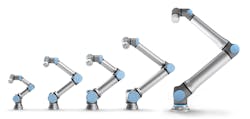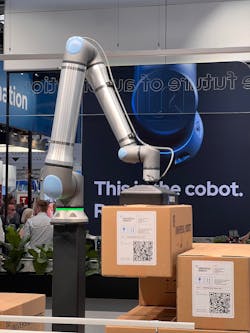Universal Robots Unveils New 20kg Payload Cobot
Universal Robots’ collaborative robots (cobots) are well-recognized due to their wide use across industry. The distinct visual look of Universal Robots’ (UR) cobots, while still familiar, has received an update with the release of the company’s new UR20 six-axis cobot.
Features of the UR20 include:
- A 20kg (44.1lbs.) payload capacity, which is 4kg more than UR’s previous heaviest load capability of 16kg with its UR16e cobot.
- Reach of 1750mm, which is 450mm more than longest previous UR cobot reach of 1300mm with the UR10e.
- Weight of the UR20, at 141.1 lbs., is nearly double the heaviest UR cobot, the UR10e, at 73.9 lbs.
- At 245mm, the footprint of the UR20 is 55mm larger than the footprint of UR’s URe10 or UR316, both of which have a footprint of 190mm.
These changes to the size, reach, and payload capacity of the UR20, compared to other UR cobots, are part of the company’s vision of “making a better work environment for what we call human scale automation,” said Anders Billesø Beck, vice president of strategy and innovation at Universal Robots.
While the exterior changes to the UR20 are minimal yet noticeable, the biggest changes took place in the interior mechanical design.
To carry the heavier payload and deliver the longer reach of the UR20 required UR’s designers to do a “complete mechanical reengineering of the whole UR system concept,” said Beck. “We hardened the design concept and shifted generations on a lot of technologies to deliver way more torque into the same package to reduce weight. This reduction in weight matters a lot to the collaborativeness of the robot because, in the end, it's all about having low momentum to move mass while keeping people safe.”
Beck noted the designers also changed the tool flange diameter for the UR20 due to the requirements of the heavier payload capacity.
With all the mechanical changes introduced by the UR20, Beck pointed out that changes were also necessary to UR’s safety system, though these changes are largely transparent to users. “Our safety system architecture was designed with scalability in mind. So we’ve been able to keep the same experience, look, and feel that our customers are used to.”
In keeping with UR cobots’ ease of use, Beck noted that the UR20 can plug into a standard wall socket to receive the power needed for operation and be moved from location to location like UR’s other cobots. The UR20, even though it is UR’s heaviest robot, “is the lightest robot of its kind with this payload and speed,” said Beck. “And you don’t need to create a big concrete foundation for this robot. We've made a lot of advancements to eliminate the need for that, such as an advanced motion and dampening algorithm to provide flexibility and suppress any excess motion.”
In addition to palletizing, Universal Robots said the UR20 can be used for welding, material handling, and machine loading and tending.
The introduction of the UR20 also marks the beginning of UR’s next generation of cobots. Kim Povlsen, president of UR, said, “We’re launching our next generation with this high-payload model first because it will make end-to-end automation a reality for our customers, allowing them to use cobot automation to cover new tasks. The next step in redefining automation will be to bring the same innovative features to a new family of cobots.”
Details on this new family of cobots is still to come.
The UR20 is expected to be available for pre-order in late Q4 2022 and will begin shipping in Q2 2023.
About the Author
David Greenfield, editor in chief
Editor in Chief

Leaders relevant to this article:


